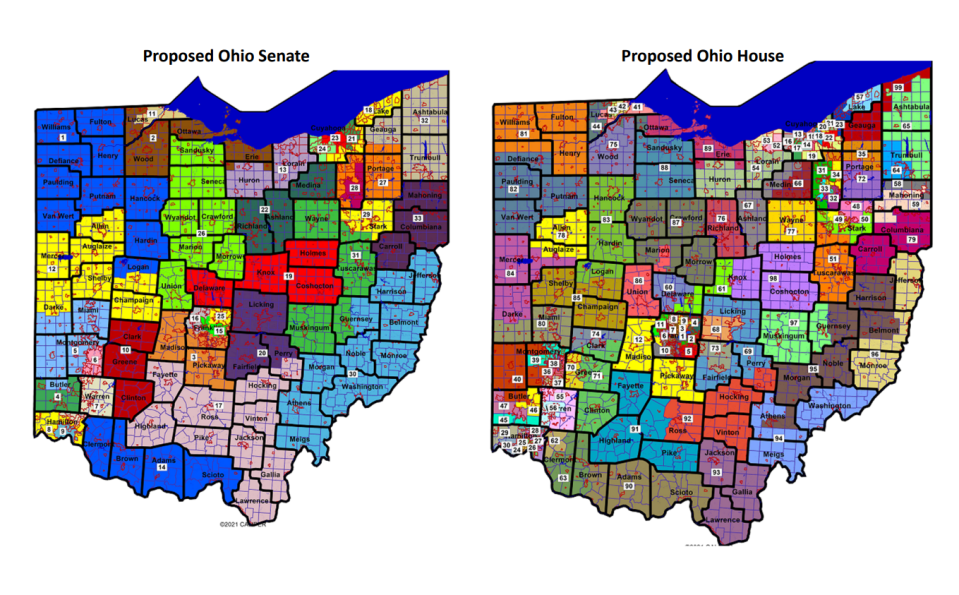New maps would give GOP more of an advantage. Would the Ohio Supreme Court prevent it?

- Oops!Something went wrong.Please try again later.
Editor's note: An earlier version incorrectly stated that Rep. Rich Brown, D-Canal Winchester, was term-limited. He is able to run in 2024.
New GOP-crafted legislative maps would give Republicans more of an advantage in House and Senate races than an unconstitutional plan used in the 2022 elections.
Democrats say that's a problem that needs to be fixed for them to vote on new maps. But the Ohio Supreme Court under new leadership might not agree − assuming mapmakers hit all the technical requirements.
The seven-member Ohio Redistricting Commission meets again Tuesday morning to hear from Ohioans worried about fair representation at the statehouse. That will wrap up a whirlwind, three-location listening tour that began Friday at Deer Creek State Park.
A vote on new legislative maps could come as soon as this week. Meanwhile, a ballot campaign is looming to replace politicians with a 15-member citizens commission instead.
Here's what you need to know about Ohio's current effort to draw state House and Senate maps:
Who has the advantage?
Most of the redistricting fights between Republicans and Democrats have focused on whether proposed statehouse maps match the statewide political preferences of Ohio's voters − or if they even need to try to hit that balance.
Last year, the Ohio Supreme Court repeatedly ruled that maps had to hit, or come very close to hitting, 54% of districts favoring Republican and 46% of districts favoring Democratic − the average statewide vote between 2012 and 2020. Justices later criticized mapmakers for creating too many Democratic districts that were more like tossups.

Those tossup districts were a key reason why the Ohio Supreme Court ruled that the maps used in the 2022 elections were unconstitutional.
On paper, these 2022 maps had 54% of districts favoring Republicans and 46% favoring Democrats. However, Republicans won 12 of 19 tossups in the House last year and all seven tossup districts in the Senate, resulting in the GOP controlling nearly 65% of the House and 79% of the Senate.
New maps proposed by Republicans last week would result in nearly 63% of House districts favoring the GOP and almost 70% of Senate districts favoring Republicans. That's an increase in the GOP's advantage over maps used in the 2022 elections.
Of those seats, 11 in the House (eight Democratic and three Republican) and four in the Senate (two Democratic and two Republican) would be considered a tossup (between 48% and 52%), according to map data uploaded on the Ohio Redistricting Commission's website.
If Republicans control more than 60% of seats, they can override the governor's vetoes without help from Democrats. The concept is called a supermajority or a veto-proof majority.
Will this fight matter to the new Ohio Supreme Court?
The Ohio Supreme Court has a new leader: Chief Justice Sharon Kennedy replaced Maureen O'Connor, the swing vote on past rulings. While both judges are Republicans, they found themselves on opposite sides of the redistricting rulings last year.
Kennedy would have approved the GOP-passed maps in 2022 because, in her opinion, the Ohio Supreme Court doesn't have the authority to review whether maps match voters' political preferences if mapmakers hit all the technical marks, according to her dissent. She called that section of the Ohio Constitution "nonmandatory."
"The Ohio Constitution requires the redistricting commission to follow politically neutral map-drawing practices and directs the commission to attempt to adopt a plan that gives proportional representation, but it does not eliminate the dilution of some electors’ voting strength," Kennedy wrote in her first dissent.
If Republicans and Democrats can't agree, the penalty is maps that last for four years instead of 10, Kennedy wrote. "The remedy provided by the Constitution may not please all Ohio voters, but this court does not have license to demand by judicial fiat the adoption of a new General Assembly-district plan."
Presumably, Kennedy would maintain this position on future map challenges before the court, where Republicans hold four of the seven seats.
The only new member of the court is Justice Joe Deters, a Republican with close ties to the DeWine family. Deters has no substantive track record on redistricting, having served as Hamilton County prosecutor and Ohio treasurer, but is expected to rule with fellow Republicans.
Who's getting a safer seat?
While many lawmakers would continue to compete for districts with a similar breakdown of Republicans and Democrats, there are some winners in the newly proposed map.
Sen. Michele Reynolds, R-Canal Winchester, just won a competitive Senate race against Democratic incumbent Tina Maharath in 2022. Under the new map, Reynolds' suburban Columbus district would extend to GOP-heavy Madison and Pickaway counties, flipping that district from one favoring Democrats to one easily favoring Republicans.
In exchange, Republicans are effectively giving up a seat currently held by term-limited Sen. Stephanie Kunze, R-Hilliard in the northwest portion of Franklin County. Under the new map, the Democratic district would include Dublin, Hilliard, Worthington and portions of Columbus.
Sen. Theresa Gavarone, R-Bowling Green, currently represents a portion of Toledo, where Democratic voters make that district a difficult one for the GOP to win. Under the new proposal, Sen. Paula Hicks-Hudson, D-Toledo, would represent the whole city, giving Hicks-Hudson a more Democratic seat and Gavarone a more Republican one.
Sen. Catherine Ingram, D-Cincinnati, would represent all of Cincinnati under the new proposal, making her district more Democratic and the remaining two state Senate seats in Hamilton County slightly more Republican.
Rep. Josh Williams, R-Sylvania, would be the beneficiary of one of the oddest-shaped districts on the proposed map. The 44th House District, which would favor Republicans by about 9 percentage points, would stretch along the Maumee River to pick up GOP suburbs in Toledo's Lucas County. Rep. Derek Merrin, R-Monclova Township, currently resides in this district, but he is term-limited.
Under the new proposal, the southern Franklin County House district currently represented by Rep. Richard Brown, D-Canal Winchester, would be divided into two districts that favor Republicans. Rep. Dave Dobos, R-Columbus, would have an easier road to reelection with a district including Grove City, Darbydale and southwestern Franklin County. The southeastern Franklin County district would include Reynoldsburg and Obetz
Under the proposed map, eliminating a portion of Cincinnati from the 27th House District, currently represented by Rep. Rachel Baker, D-Cincinnati, would give Republicans a better shot at winning the already competitive tossup district.
By splitting Athens County in two, the 94th House District, currently represented by term-limited Rep. Jay Edwards, becomes more Republican.
Are Democrats being packed into urban districts?
Sen. Kent Smith, D-Euclid, told the Ohio Redistricting Commission Monday that Democrats were being overstuffed into urban districts to create more Republican seats in the surrounding areas.
“This repeated scheme cannot be a coincidence," Smith said.
On the proposed map, Democrats would represent eight of the 10 most populous House districts and three of the 10 most populous Senate districts. Smith's 21st Senate District would be the most populous in the state.
Each House district must be roughly equal, varying between about 113,200 residents and 125,100 residents. No district exceeded the permitted population, according to map data uploaded on the Ohio Redistricting Commission's website.
Jessie Balmert is a reporter for the USA TODAY Network Ohio Bureau, which serves the Columbus Dispatch, Cincinnati Enquirer, Akron Beacon Journal and 18 other affiliated news organizations across Ohio.
Get more political analysis by listening to the Ohio Politics Explained podcast
This article originally appeared on Cincinnati Enquirer: Ohio redistricting: New maps would give Republicans more of an edge

